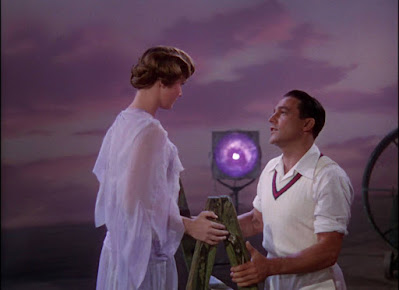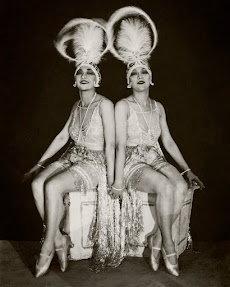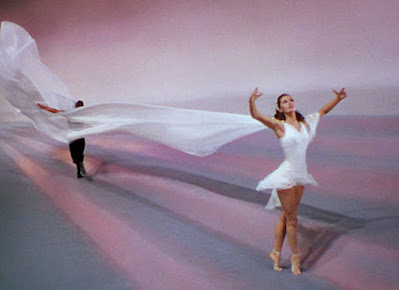
Singin' in the Rain is one of those gorgeous films where you can pause at any moment and it might as well be a painting. Besides being an iconic movie, it's a stunning combination of Technicolor and fashion - which is why I decided to round up the costumes in one big stunning survey. Here it is: the Singin' in the Rain Costume Analysis!
Scene One: The Movie Premiere
At the beginning of Singin' in the Rain, Don Lockwood (Gene Kelly) and Lina Lamont (Jean Hagen) are at the premiere of their latest film, The Royal Rascal. The year is 1927, and silent films are just making the switch over to talkies. Don and Lina are dressed in coordinating white outfits - because they're such an amazing screen team who totally adore each other! (Sarcasm intended.) Even though Don can't stand Lina, their matchy-matchy outfits turn them into a unit. Don wears a trench coat over his tuxedo, and Lina's in a sparkly sequin fur wrap, matching gown, and diamond jewelry. Bonus: Rita Moreno in an early role, wearing a gorgeous fur wrap and sequin flapper dress complete with red curls to channel the full Clara Bow look.
1920s Accuracy Score: 9/10
Pretty accurate! Big fur wraps were super popular in the '20s (though not as glittery), tuxedos never really went out of fashion for formal events, and even Dora Bailey the radio reporter has a drop-waist floral dress that wouldn't be out of place in 1927.
Scene Two: Kathy's Car Escaping from Lina and a mob of fans who ripped his tuxedo, Don hops into the car of a stranger - Kathy Selden (Debbie Reynolds). Kathy wears a monochrome brown outfit: tan V-neck dress, brown scarf, and matching hat. She looks quite put-together and professional, like any 1920s working girl in Hollywood. Kathy's modest, somewhat-boring outfit in this scene gives a nice contrast with the next time we see her.
1920s Accuracy Score: 7/10 Though coordinated "motoring outfits" were a thing in the '20s, the silhouette of Kathy's with its puffed sleeves and little V-neck isn't quite right and neither is the plain, heavy fabric. Her hat is almost a cloche, the dominant women's hat fashion of the 1920s, but its edges would have been rounded to fit snugly over Kathy's hair.
Here's a picture of a fashionable 1920s motoring outfit for reference!
Scene Three: The Party
Don heads over to the post-premiere celebration, and gets more than one surprise: talking pictures are all the rage and his silent movie days are ending, plus Kathy Selden is the party entertainment! All the men are still in tuxedos, and the showgirls are in adorable pink-and-gold costumes covered in ribbons and tulle. Kathy and the girls sing "All I Do is Dream of You" while Don watches in wonder. After the performance, Kathy faces off with the jealous Lina and throws cake in her face. "Here's one thing I learned from the movies!"
1920s Accuracy Score: 10/10 "Anything goes" was the general attitude towards early showgirl costumes. Sequins, sparkles, crazy headpieces, hats, crowns, pearls, diamonds - you name it. Kathy's girls wear headpieces similar to cloche hats and their minidress costumes wouldn't have been out of place in the Ziegfeld Follies or any other musical revue of the 1920s. Everything from the puffy bracelet accessories to the curls peeking out from under their hats is spot-on accurate!
Scene Four: Back On Set Kathy disappears after the whole cake incident, leaving the lovesick Don to wander around aimlessly on set. His good friend Cosmo Brown (Donald O'Connor) cheers him up with the incredible song/dance/stunt performance of "Make 'Em Laugh". (Fun fact: "Make "Em Laugh" was a last-minute comedic relief addition, and the producer told the songwriters to give him something like "Be a Clown" from the last Gene Kelly musical, The Pirate. What they did was change "be a clown" to "make 'em laugh" and keep the exact same melody.) Don wears an ugly gray-checked suit and Cosmo wears an equally ugly combination of brown corduroys, gray collared shirt, and tan fedora.
1920s Accuracy Score: 5/10
Okay, so maybe Don's paperboy cap and Cosmo's fedora are technically accurate and the silhouettes are mediocre at best, but what is with the colors? The patterns? Costume design really took a nosedive for this scene.
Scene Five: The Dueling Cavalier
"Make 'Em Laugh" does the trick, and Don is fit as a fiddle to start filming his newest silent movie with Lina, The Dueling Cavalier. They get dressed in their ridiculous period-drama costumes and bicker the whole time because - gasp! - Lina got Kathy fired from her job after the cake-throwing fiasco. Now Don is angrier than ever with his whiny co-star, which presents a problem for filming a romance.
French Revolution Accuracy Score: 0/10
Just no. For a film supposedly set during the French Revolution, The Dueling Cavalier looks like a Halloween craft project. Lina's wannabe Marie Antoinette gown would have been 20 years out of fashion by the 1790s, and so would her hair. Don's suit is a mix of terrible modern tailoring, George Washington hair, and a cheap-looking brocade fabric. For an 18th century fashion enthusiast, this is a nightmare (can you tell?).
Scene Six: Beautiful Girl
While Don is struggling with the cancellation and re-vamp of The Dueling Cavalier as a talkie, Kathy is filming a chorus girl musical on the same lot. The "Beautiful Girl" montage is a series of, well, beautiful girls in various matching costumes. It leads into a fashion montage á la The Women, which I won't cover in detail but pretty much looks like Walter Plunkett pulled several all-nighters, bought way too much neon satin, and started designing. (I should give poor Walter Plunkett justice and mention that he's most famous for Gone With the Wind's costumes and also designed the gorgeous wardrobe Ginger Rogers wears in The Gay Divorcee).
1920s Accuracy Score: 9/10
The "Beautiful Girl"
dresses are a breath of fresh air after Hobby Lobby Marie Antoinette.
Drop-waists, pleated skirts, ribbon sashes, and satin heels all scream
1920s. Even if the shimmery purple fabric probably wouldn't have been
the go-to, it sure looks nice in Technicolor! And the two-part skirt
and flounce look like a version of the "robe de style" that was so
characteristic of the '20s.
Scene Seven: You Were Meant for Me
Don escapes moviemaking chaos and finds Kathy to confess his love, which he can only do with sunset lighting on an abandoned soundstage. Obviously. In all seriousness, this is my favorite part of Singin' in the Rain, simply because it's so gorgeous. Kathy's still in her "Beautiful Girl" dress, which matches the cloudy sky backdrop dreamily, and Don wears a simple white outfit complete with a cute V-neck sweater vest. Perfection.
1920s Accuracy Score: 9/10
Don's outfit would be right at home on any golf course or movie studio in the '20s - it's the quintessential California-man outfit beloved by early movie directors and wealthy country club guests.
Scene Eight: Diction Lessons
In an effort to get them ready for a talkie, Don and Lina are rushed into diction lessons. For Lina, this means trying and failing to overcome her squeaky/nasal/Southern voice ("ah can't stan' 'im!") and for Don, this means completely avoiding work to perform a full-out dance number with Cosmo. "Moses Supposes" is a really fun number with some really fun costumes, including a Cruella-looking outfit for Lina and some good old sweaters for Don and Cosmo.
1920s Accuracy Score: 10/1o
Lina's outfit is pitch-perfect (pun intended). Any '20s socialite would be the height of fashion in her cloche hat, high collar, satin gown, fur wrap, and Art Deco gloves. Don and Cosmo are essentially wearing the casual 1920s uniform: slacks, collared shirt and tie, sweater, and two-tone shoes. '20s menswear doesn't get much better than this!
After a disastrous preview of The Dueling Cavalier, where Lina's voice sends the audience into hysterics, Don, Kathy, and Cosmo pull an all-nighter and come up with a plan. Kathy will sing and voice Lina's part, and Lina will lip-synch along. Everybody will be happy, and nobody will be upset or jealous at all! (Sarcasm again.) One of the movie's most fun songs, and also my alarm clock sound, it's "Good Morning!" Also featuring one of Kathy's best outfits, a lightning-pattern sweater vest and skirt, and some great waistcoats for Don and Cosmo.
1920s Accuracy Score: 8/10
Kathy's outfit is wonderful, but her skirt is a little too short for '20s modesty, and that sweater vest needs a collared shirt underneath. The men are pretty accurate - and look at Cosmo's rainbow tie!
Interlude: Singin' in the Rain
What, no pictures? For this iconic number? Fashion-wise, Don's in his same-old suit, and to keep this already-long article a little shorter we're going to focus on the *fashion* (sorry, Gene Kelly).
Lina begrudgingly agrees to have her voice dubbed by Kathy, and we get to watch Debbie Reynolds sing "Lucky Star" (with her voice dubbed, ironically).
1920s Accuracy Score: 6/10
Kathy's dress is fun, but it's very 1930s, not '20s. Short ruffled sleeves, diagonal inserts, and bright patterns are all '30s trademarks. Her short waved bob is very accurate, though! As for Lina... I'm not quite sure what's going on with her outfit. The hat is nice, the leather gloves are great (Lina wins in the accessories department), but something about the Greek-toga-meets-1920s-old-lady is a little strange.
Scene Eleven: Gene Kelly's Ego-Fueled Fever Dream feat. Cyd Charisse
Okay, okay, it's called Broadway Melody. But every Gene Kelly film has that random superman ballet sequence - you know the one. Completely unattached from the plot, basically just a chance for him to show off, they're everywhere. Broadway Melody rubs me the wrong way because it's almost as if he threw the whole sequence in to be like "look how well I can dance when I'm not stuck with an untrained 19-year-old!" Poor Debbie Reynolds. Let's use this scene to appreciate the incredible Cyd Charisse, who never receives half her due admiration, and her fancy costumes.
1920s Accuracy Score: 0/10
This scene basically upholds the fake, cartoonish image of the 1920s that most people have. Nobody in their right mind in the '20s wore the outlandish neon flapper dresses so common in Halloween stores today. Cyd Charisse's mile-long white dress is a gorgeous ballet costume, but not exactly 1920s. I was lucky enough to see this dress in person in a costume exhibit, and it is just as lovely in real life!
At the premiere of the renamed film The Dancing Cavalier, Lina "performs" with her voice dubbed from behind a curtain. But out of spite for Lina, Don and Cosmo raise the curtain to reveal the biggest hoax in Hollywood. Gasp! Lina is ridiculed, Kathy becomes a star, and it all ends up happily ever after (for the two lovebirds, that is.)
1920s Accuracy Score: 1/10
One point for Lina's feather headband, I guess? Her sequin gown is giving Marilyn Monroe, and Kathy is wearing a straight up 1950s teenage prom dress extravaganza.
That's a wrap, folks! If you stuck around until the end, thank you so much for reading my Singin' in the Rain costume analysis! It was a whole lot of fun to write and research. Another big thank you to The Classic Movie Muse for hosting such a wonderful blogathon!





































This was absolutely fascinating! I loved reading your analysis (and getting a chance to look at all the gorgeous costumes again). Walter Plunkett is one of my favorite film costume designers, and I loved getting to hear how accurate/inaccurate his costuming was.
ReplyDeleteThank you so much! I love Walter Plunkett's costumes and it was so much fun to take a deeper look at these ones.
DeleteMaeve, this is teriffic! I love how you included the accuracy of the costumes and a picture of the 1920's looks for reference. (That motoring outfit - so pretty!) Walter Plunkett did some beautiful work here which you've highlighted so wonderfully. Thank you so much for contributing this delightful post to my blogathon!
ReplyDeleteThank you so much for hosting such a fun blogathon!
DeleteWonderful post. And please don't forget Lina's monkey futr coat and those stunning sunglasses.
ReplyDeleteOf course! There are so many gorgeous costumes - if I had room to include them all, I would have :)
DeleteThis was so interesting! The part about "Hobby Lobby Marie Antoinette" especially cracked me up. :-)
ReplyDeleteMaeve, you certainly know a lot about fashion history. That's why this post was so enjoyable to see and read. Congratulations on this great research.
ReplyDeleteCheers!
Le
This was an awesome read! I think its interesting how the 20s aspect hold up when the costumes were made with a 50s mindset! Love how you didnt hold back your honesty- even if that meant a costume looking stylistically pretty, but being inaccurate!
ReplyDeleteEmily- The Flapper Dame
Reading this now because of the CMBA Awards ballot and love it!
ReplyDelete" The Dueling Cavalier looks like a Halloween craft project." lol :') That was such a captivating and informative read! I loved to learn about the accuracy of the costumes. I wrote costumes analysis on my blog The Wonderful World of Cinema on two occasions I believe. They're always a lot of fun to do!
ReplyDelete